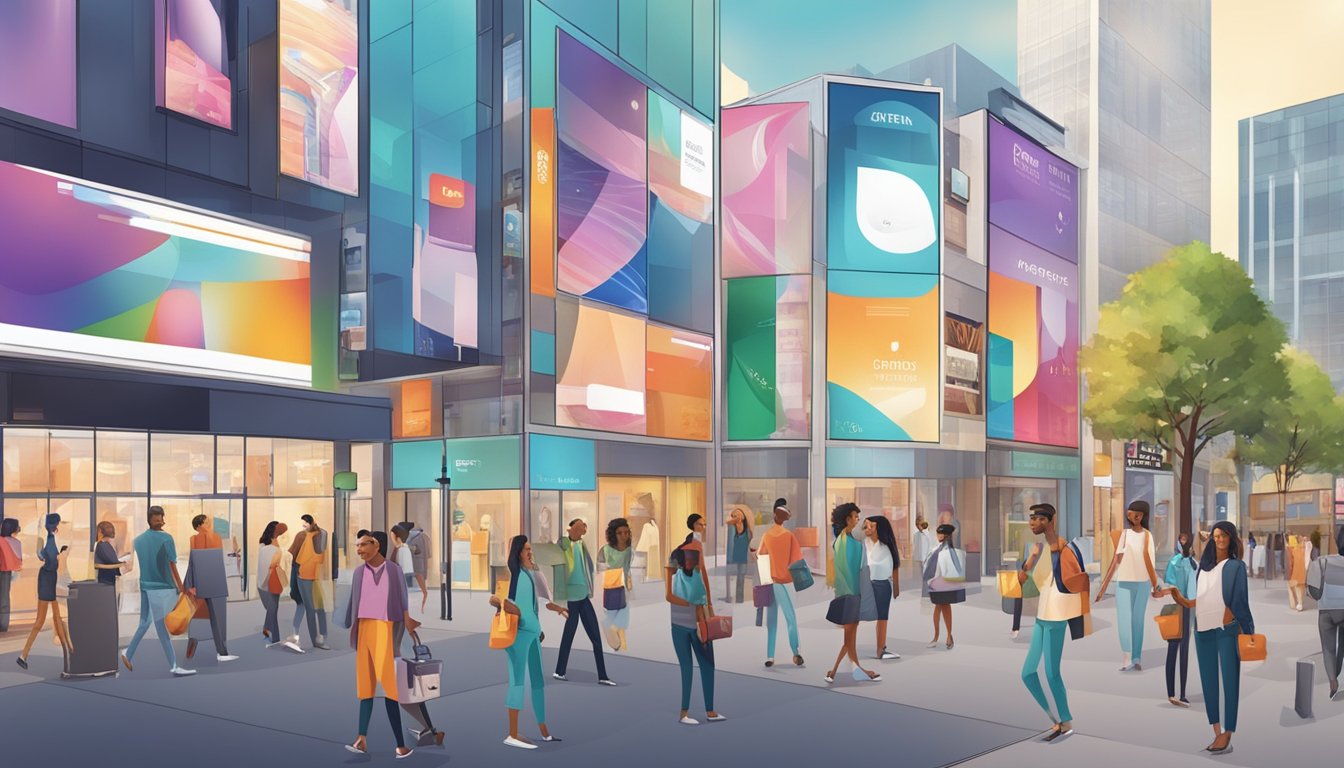Advertising and integrated brand promotion are essential components of any business’s marketing strategy. Advertising is the process of promoting a product or service to potential customers, while integrated brand promotion involves using a range of marketing techniques to create a cohesive brand identity. These techniques include advertising, public relations, sales promotion, direct marketing, and personal selling.

The Evolution of Advertising has seen a shift from traditional methods such as print and television advertising to digital marketing techniques such as social media and search engine optimization. Understanding Consumer Behaviour is also a crucial aspect of advertising and integrated brand promotion. By analyzing consumer behavior, businesses can tailor their advertising and promotional strategies to better target their desired audience.
Strategic Brand Promotion involves creating a unique and recognizable brand identity that resonates with consumers. This can be achieved through consistent branding across all marketing channels, including advertising, packaging, and social media. Advertising in Action involves implementing advertising campaigns that effectively communicate the brand’s message to consumers. Finally, Emerging Trends and Practices in advertising and integrated brand promotion are constantly evolving, and businesses must stay up-to-date with the latest trends to remain competitive.
Key Takeaways
- Advertising and integrated brand promotion are essential components of any business’s marketing strategy.
- Understanding consumer behaviour and creating a unique brand identity are crucial aspects of advertising and integrated brand promotion.
- Staying up-to-date with emerging trends and practices is essential for businesses to remain competitive in the market.
The Evolution of Advertising

Over the years, advertising has undergone significant changes, with the rise of integrated brand promotion, the influence of e-commerce, and globalization being some of the major factors that have shaped the industry.
Rise of Integrated Brand Promotion
Integrated brand promotion is a marketing strategy that combines different advertising and promotional tools to create a comprehensive, cohesive message that resonates with consumers. This approach has become increasingly popular in recent years, as companies seek to create a consistent brand image across different channels, including print, social media, and e-commerce.
One of the key advantages of integrated brand promotion is that it allows companies to reach a wider audience and engage with consumers in a more meaningful way. By using a range of advertising and promotional tools, companies can create a more immersive brand experience that resonates with consumers on a deeper level.
Influence of E-Commerce on Advertising
The rise of e-commerce has also had a significant impact on advertising, with companies increasingly using digital channels to reach consumers. Social media platforms such as Facebook, Instagram, and Twitter have become key advertising channels, with companies using these platforms to target specific demographics and promote their products and services.
E-commerce has also enabled companies to create more personalized advertising campaigns, with data analytics and machine learning algorithms allowing companies to target specific consumers with tailored messaging and offers.
Globalisation and Advertising
Finally, globalization has also had a significant impact on advertising, with companies increasingly looking to expand their reach beyond their domestic markets. This has led to the emergence of global advertising campaigns, with companies using a range of advertising and promotional tools to create a consistent brand image across different countries and cultures.
Globalization has also led to the emergence of new advertising trends, such as cause-related marketing, which seeks to align brands with social and environmental causes to create a more positive image in the eyes of consumers.
In conclusion, advertising has come a long way over the years, with integrated brand promotion, e-commerce, and globalization being some of the major factors that have shaped the industry. As companies continue to adapt to changing consumer preferences and new technologies, it will be interesting to see how advertising continues to evolve in the years to come.
Understanding Consumer Behaviour

To effectively advertise and promote your brand, you need to understand consumer behaviour. This includes online consumer behaviour, the impact of social media, consumer psychology, and market segmentation.
Online Consumer Behaviour
Online consumer behaviour is the actions and decisions made by consumers when shopping online. It includes their browsing habits, purchase decisions, and post-purchase behaviours. Consumers are more likely to shop online if the website is easy to navigate, has clear product descriptions, and offers a secure checkout process. They also tend to look for reviews and ratings before making a purchase.
Impact of Social Media
Social media has a huge impact on consumer behaviour. Consumers use social media to research products and services, read reviews, and share their experiences with others. Social media platforms also allow brands to interact with consumers, build relationships, and create a loyal following. It is important for brands to have a strong social media presence to connect with their customers and increase brand awareness.
Consumer Psychology and Segmentation
Consumer psychology is the study of how consumers think, feel, and behave. Understanding consumer psychology can help brands create effective advertising and marketing campaigns. Market segmentation is the process of dividing consumers into groups based on their demographics, behaviours, and preferences. This allows brands to tailor their advertising and marketing efforts to specific consumer groups.
In conclusion, understanding consumer behaviour is essential for effective advertising and integrated brand promotion. By understanding online consumer behaviour, the impact of social media, consumer psychology, and market segmentation, brands can create targeted campaigns that resonate with their audience and drive sales.
Strategic Brand Promotion

Developing a Value Proposition
When it comes to advertising and integrated brand promotion, developing a unique value proposition is key to standing out from the competition. Your value proposition should clearly communicate the benefits and value that your brand offers to potential customers. To develop a strong value proposition, you need to understand your target audience and their needs, as well as your brand’s strengths and unique selling points. This will help you create a message that resonates with your audience and sets your brand apart.
Positioning and Brand Strategy
Positioning your brand in the market is crucial to your success. You need to identify your target audience and understand how they perceive your brand. Once you have this information, you can develop a brand strategy that aligns with your target audience’s needs and preferences. This includes creating a brand identity, messaging, and tone of voice that resonates with your audience and sets your brand apart from competitors.
Media Planning and Creative Process
Media planning and the creative process are essential to advertising and integrated brand promotion. You need to select the right channels to reach your target audience and develop creative content that engages them and communicates your brand’s message effectively. This includes creating compelling visuals, copy, and calls to action that encourage your audience to take action.
Overall, strategic brand promotion is about creating a unique and compelling message that resonates with your target audience and sets your brand apart from the competition. By developing a strong value proposition, positioning your brand effectively, and creating engaging content, you can build a successful marketing strategy that drives results. So, take the time to understand your audience and invest in the creative process to create a winning brand promotion strategy that delivers real results.
Advertising in Action

Advertising is a powerful tool for promoting your brand and increasing sales. To make the most of your advertising campaigns, you need to work with an advertising agency that understands your brand and your target audience.
Role of Advertising Agencies
An advertising agency can help you develop creative and effective advertising campaigns that resonate with your target audience. They can also help you with advertising research, which can help you understand your target audience better and develop more effective campaigns.
When choosing an advertising agency, look for one that has experience working with brands in your industry and has a track record of success. You should also look for an agency that is willing to work with you to develop campaigns that align with your brand values and goals.
Campaign Execution and Sales Promotion
Once you have developed your advertising campaigns, it’s time to execute them. This involves creating ads that are eye-catching and engaging, and placing them in locations where your target audience is likely to see them.
Sales promotion is another important aspect of advertising. This involves offering discounts, coupons, or other incentives to encourage people to buy your products or services. Sales promotion can be an effective way to drive sales and increase brand loyalty.
Measuring Advertising Effectiveness
To ensure that your advertising campaigns are effective, you need to measure their effectiveness. This involves tracking metrics such as click-through rates, conversion rates, and return on investment (ROI).
By measuring the effectiveness of your advertising campaigns, you can identify areas for improvement and make adjustments to your campaigns to improve their effectiveness.
In conclusion, advertising is a powerful tool for promoting your brand and increasing sales. By working with an advertising agency, executing effective campaigns, and measuring their effectiveness, you can make the most of your advertising efforts and achieve your business goals.
Emerging Trends and Practices

As the world of advertising and integrated brand promotion continues to evolve, it is important to keep up with the latest trends and practices. In this section, we will explore some of the emerging trends that are shaping the industry.
Influencer and Peer Marketing
Influencer marketing has been on the rise in recent years, and it shows no signs of slowing down. By partnering with influencers, brands can reach a wider audience and build trust with their target market. Peer marketing is also becoming increasingly popular, with brands tapping into the power of word-of-mouth recommendations to promote their products.
Branded Entertainment and Sponsorships
Branded entertainment and sponsorships are another effective way to promote your brand. By partnering with popular TV shows, movies, or events, you can increase your brand’s visibility and reach a wider audience. Product placements in movies and TV shows are also a popular way to promote your brand.
Digital Innovations in Advertising
Digital innovations in advertising have opened up new opportunities for brands to reach their target market. From social media advertising to programmatic advertising, brands can now reach their audience in more targeted and effective ways than ever before. Design thinking is also becoming increasingly important in advertising, as brands seek to create more engaging and interactive campaigns.
Overall, staying up-to-date with the latest trends and practices in advertising and integrated brand promotion is essential for success in today’s market. By embracing new technologies and strategies, you can reach your target market more effectively and build a stronger brand presence.
Frequently Asked Questions

How can one effectively measure the success of an integrated brand promotion campaign?
Measuring the success of an integrated brand promotion campaign can be a complex process. However, there are several key performance indicators (KPIs) that you can use to effectively measure the success of your campaign. These include increased website traffic, social media engagement, sales volume, customer retention, and brand awareness. By tracking these KPIs, you can gain valuable insights into the effectiveness of your campaign and make necessary adjustments to improve its performance.
What are the latest trends in media planning for enhancing brand visibility?
In recent years, the rise of digital media has revolutionised the way that brands approach media planning. The latest trends in media planning include the use of social media influencers, personalised advertising, and programmatic advertising. These strategies can help brands to enhance their visibility and reach a wider audience.
Which strategies are most effective for synchronising advertising efforts across multiple platforms?
To synchronise advertising efforts across multiple platforms, it is important to develop a cohesive brand message that can be easily adapted to different platforms. This can be achieved through the use of a centralised marketing team, the development of a comprehensive brand style guide, and the use of data-driven insights to inform advertising decisions.
What are some innovative examples of integrated brand promotion in recent years?
In recent years, there have been several innovative examples of integrated brand promotion. These include the use of augmented reality experiences, interactive billboards, and immersive pop-up shops. These strategies can help brands to create memorable experiences for their customers and increase brand awareness.
How does one differentiate between marketing, advertising, and promotion in the context of brand strategy?
Marketing, advertising, and promotion are all important components of a comprehensive brand strategy. Marketing refers to the overall strategy that a brand uses to reach its target audience, while advertising involves the creation and distribution of specific promotional messages. Promotion refers to the various tactics that a brand uses to increase awareness and drive sales. By understanding these differences, brands can develop a comprehensive strategy that effectively reaches their target audience.
What are the key components that contribute to the creation of a unique brand identity in a competitive market?
Creating a unique brand identity in a competitive market requires a combination of several key components. These include a strong brand mission and values, a distinctive brand voice and personality, a comprehensive brand style guide, and a consistent visual identity. By developing these components, brands can create a unique identity that resonates with their target audience and sets them apart from their competitors.




